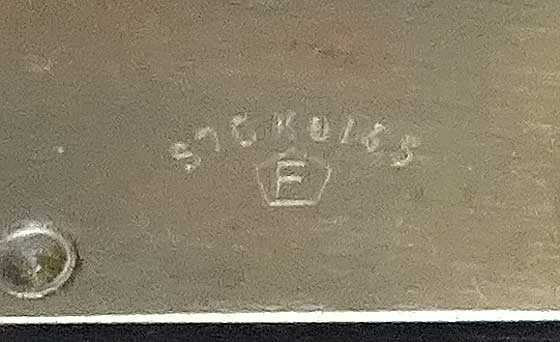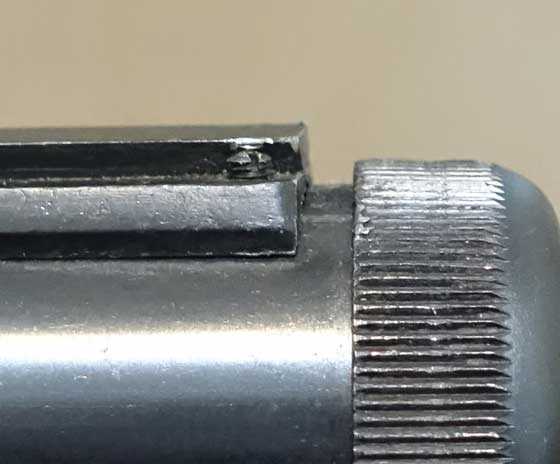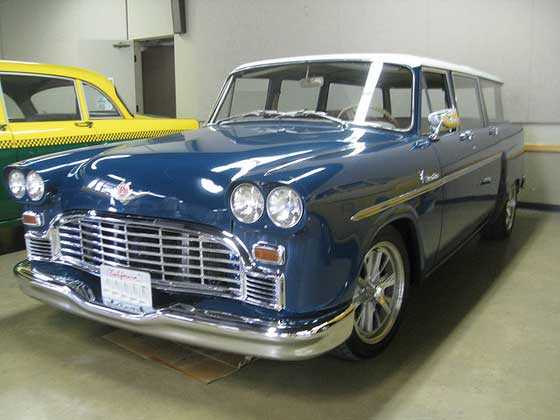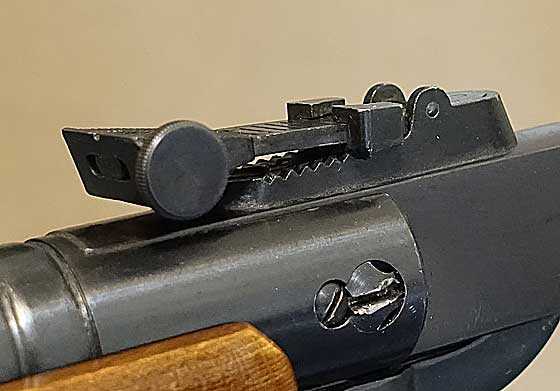by Tom Gaylord
Writing as B.B. Pelletier

BSF S70 rifle is the father of several famous Weirauch models.
This report covers:
- It’s here!
- History
- Related models
- Whadda we got?
- Trigger
- Sights
- Summary
It’s here!
I told you about this BSF S70 rifle a couple weeks ago. I thought I didn’t win it in the online auction, but in fact, I did.
I have tested an S70 for you in the past. So, what’s so special about this one? Well, the truth is, that other S70 had some problems. First, it had no rear sight — just an optional peep that was sold by Air Rifle Headquarters and Beeman in the 1970s and ’80s. Next, it was very powerful. Though it carried the German Freimark that is put on all airguns of less than 7.5 Joules (5.53 foot-pounds), that rifle was producing over 12 foot-pounds. Either someone had been inside, or something funny was going on with the Freimark.

That F inside the pentagram is the German Freimark (free mark). It means the airgun develops less than 7.5 joules and is free from ownership restrictions.
The third problem was at sometime in that rifle’s past someone had pulled the trigger with the barrel broken open, and the rapid slamming shut had bent the barrel upwards. It was so bad that I wrote an entire series about bending airgun barrels — just so I could fix this one. At the end of that series I got that rifle shooting where the sights looked, and it is now a real pleasure to shoot. But in retrospect, did I actually test a BSF S70? Given everything I just told you, I think not.
History
The S70 is the deluxe version of the BSF S55, which was one of the 4 most powerful spring-piston air rifles in the world in the 1970s. The other three were the RWS 45, the HW 35 and the FWB 124. Of these, the RWS 45 and the BSF S55/70 vied for the top spot. Robert Law of ARH talked about these rifles exceeding 865 f.p.s. when fully broken in and lubricated. The S70 I just mentioned averaged 868 f.p.s with RWS Hobby pellets.
BSF is a contraction of the company name — Bayerische Sportwaffenfabrik. They were headquartered in Erlangen, just north of Nuremberg, Germany. Erlangen, by an ironic coincidence, is the town where I was stationed with the Army from 1974-1977. I didn’t know BSF was there, and only discovered them after returning to the United States.
BSF made some beautiful airguns, several of which I have tested for you over the years, but the S70 stands out for the influence it had on airguns we know much better. The company fell on hard times in the 1980s and was purchased by Weihrauch (before 1987). The new owners used the parts of rifles that were on hand at the time to produce two interesting new models that Marksman brought over to sell in America.
These two rifles, called the Marksman 55 and Marksman 70 (interesting model numbers), were essentially the BSF S55 and S70. Initially they came with simpler triggers that were probably the original BSF triggers. Before long, though, they were being shipped with Rekord triggers. Both Marksman rifles continued to use the BSF rear sight that we will see on this S70. Was the piston seal changed? I don’t know. Perhaps.
I don’t know how many of these two Marksman rifles were made, but it’s obvious they were made to use up the parts that Weihrauch got when they bought the BSF company. They were not new additions to the Weihrauch line. I think they all came to the United States, and they make an interesting footnote to both the BSF and Weihrauch histories.
However, the story doesn’t end there. Weihrauch had now become familiar with the insides of BSF breakbarrel powerplants, and within a short time the Beeman company, Weihrauch’s biggest North American customer, announced the Beeman R10. They called it the “son of the R1” because it produced R1 velocity while weighing several pounds less. The “secret” that allowed this to happen was a long piston stroke in a spring tube that was considerably narrower than the R1/HW80 tube.
I am not saying that the BSF S70 became the R10. I doubt there are many parts that will fit both guns without machining. But the idea of the long-stroke narrow piston was certainly how BSF achieved the power that it did. The R10 is very much a scaled-down R1, but I believe that there is at least a trace of BSF DNA in it. I know, for instance, that the R10 has a scope base that’s attached to the top of its spring tube instead of grooves cut into the spring tube, just like the BSF S70.

The scope base is attached to the top of the spring tube, rather than cut into it.

On the left rear of the scope base, a screw provides a positive mechanical stop for the rear ring. This was decades ahead of where most spring rifles were at the time.
The R10, which wasn’t a success, was soon followed by the Beeman R9 that was. The R9 was a redesign of the R10 that got most of the R10’s performance in a package that was more produceable. So, you could say that the Beeman R9 owes its existence to the influence of the BSF S55/70.
Related models
Although they aren’t seen in the U.S. as often, there is also a BSF model S60 and an S80. They fit into the scale of quality where their model numbers imply. I tell you that for the record, but know that the S55 and S70 are by far more prevalent in the U.S.
Whadda we got?
Now, let’s turn our attention to the rifle I’m testing. What is an unaltered BSF S70 rifle like? Well, they aren’t small and they aren’t large — sort of in the middle. The Blue Book of Airguns says they should weigh about 7 pounds and makes no mention of the length. Mine weighs 7 pounds on the nose and is 43.5 inches long. The barrel is 19 inches, stem to stern. The forearm is a square section that’s pleasantly thin. Overall the rifle feels and handles very much like an R9, which is to say light and easy-handling.
This is an old-school air rifle, so all the metal parts are either steel that’s been polished and blued or anodized aluminum, and there is precious little of that. The checkered panels in the forearm and pistol grip are pressed in and do nothing to help your grip. The beech stock is heavily finished with what looks like a clear synthetic finish.
Speaking of old-school, let me tell you what that means. Although this rifle could have been produced in the 1980s, its design was frozen in the 1950s. So the look , finish and materials all date to that time. It’s like a Checker Marathon in that respect.

This 1983 Checker Marathon station wagon looks like it was made in 1958.
Trigger
The trigger is adjustable, and BSF triggers are the only ones that have the adjustment instructions written on the triggerguard. The words are in German, but the plus and minus symbols tell you what the adjustments will do to the pull.

The directions for adjusting the trigger are engraved on the triggerguard.
I will say one more thing about the trigger. It is curved and the blade is slanted too far forward for my tastes. It just feels odd to my finger, and I always notice it.
Sights
The sights are conventional. Up front is a rather tall post with a bead on top. A sheetmetal hood goes over the front sight and clamps to the base, but this rifle didn’t have it when it arrived. It’s there to protect your hand while cocking, as much as anything else. The rear sight adjusts up and down via a sliding elevator up a stepped ramp. Windage adjusts with a thumbscrew and the adjustments have obvious detents. This is the sight my other S70 doesn’t have, so I finally get a chance to test it. And now I have the vision I need for the test.

The front sight is very tall. It’s supposed to have a sheetmetal hood.

The rear sight adjusts in both directions.
Summary
That’s as far as I will go today. At one time in the 1970s this rifle was at the top of the power pyramid. Today it will be a gentle shooter. I am extremely curious whether it will really have 7.5 joules of power. I’m betting it is more powerful that that.

B.B.,
Very nice. Enjoyed the history part. I would think that U.S. imports would all be the more powerful version, but perhaps not. From the looks of the end cap, front sight and barrel pivot screw, it does appear that someone has messed with it. I like the substantial rear sight with all it’s functionality.
Of most interest would be, how does a lower power airgun transform into a higher powered one? I do recall of reading that hole(s?) were drilled in the piston head of some, and plugging that hole would increase the fps. Other methods?
Good Day all,… Chris
Chris,
I have never heard of that method of power level adjustment. Where do you drill the holes? Maybe along the length of the compression chamber? This would effectively reduce the volume of swept air, thereby reducing the power.
Most often, an air rifle is designed to a certain higher power level and then modifications are made to reduce that power level to the market for which it is intended. It is difficult to increase the power level of a particular design beyond a certain point. It is much easier to reduce such. Some companies provide a longer piston to reduce the compression chamber volume of swept air. Some may use a lighter spring.
RR,
Through the head, allowing some air back into the spring area. Gotta’ go,… bye.
RR
I believe it was Dom that mentioned drilling or plugging a hole in the piston head. Maybe it was somebody else. But it was mentioned here on the blog.
Hi Chris
When Crosman started selling the Optimus, Quest and Phantom here in big box stores they lowered the power to less than 500fps by using a bleed hole in the piston head. It wasn’t long before kids learned how to get the guns apart and epoxy the bleed hole. The result, although illegal, was a whole pile of these $100 guns shooting up to 800fps!
The police, both local and federal, didn’t/couldn’t do anything about it and to date I’ve never heard of the guns being used in an improper manner.
It was rumored, however, that the local gopher population took a huge dive in numbers over the next few years!
Cheers
Dave
Dave and Gunfun,
Thanks for the back up guys. Goes to show I have not lost all of “marbles”,….. yet. A larger transfer port was the other. BB did that report awhile back when Riki asked a similar question. Displaced volume was the other. But with that,… you pretty much got what ya got.
Chris U
No problem. I don’t want you to think you lost your marbles. I remember when I did that when I was a kid. It was not no fun at all is all I can say. 😉
This reminds me of your comment about a desire to try out different guns. Mostly I can rent firearms that I like without buying them, but airguns are a different story. And that doesn’t even include vintage items like this which are also difficult to get for firearms. The only solution is an airgun show. 🙂
Matt61
Matt61
Now that would be a cool thing if the local shooting ranges had air guns to try out.
I would do that in a heart beat verses buying one all the time to try out.
I love shooting as you know. And just think of the exsposure air guns would get if that started happening at the shooting ranges.
Good GAWD!!!!!!!!!!!! That pivot screw! There should be a test before selling some CLODS screwdrivers….
BB,
Nice score! To me, this is how a quality break barrel should be made. Plastic has no place on something you intend to cherish and shoot for years to come. Those sights are awesome! Your descriptive comparisons are exactly why I desire an HW 95 / R 9, something light, easy to handle, well made and smooth shooting.
Are the rings machined into the spring tube (visible in the rear sight photo) simply decorative?
Belgrath04,
Those rings are not machined. They are swaged. That is how the end of the compression chamber is held inside the spring tube. It’s a common method of attachment from this era.
B.B.
B.B.
My brother and his wife were stationed near Mannheim for 5 years(corporate). They liked to so much that they now go spend there summer vacation in southern Germany. As my brother says, the south Germans have a lot more fun than northern Germans, what with all the wine festivals and other celebrations.
Is the HW 98 derived from the R10? Did this model influence the HW 30, 50, 95? All narrow tubed receivers?
As one of my favorite Germans used to say, “Very interesting…….”
Good article,
-Yogi
Yogi,
I don’t know about the HW 98. The HW 30 and 50 predate the acquisition of BSF, so no direct influence.
B.B.
Tom,
I used to have a Marksman 70. The rekord trigger is night and day from the original BSF trigger. I picked mine up in mint condition with original shipping box up at the Kalamazoo airgun show a couple years ago. I never ran mine across the chrony but I used to shoot steel spinners at 30 yards and it hit with authority. Mine had a synthetic piston seal and breech seal. Never got used to the side safety, just weird.
Scott
Scott,
Thank you for that report. I hope to hear from several Marksman 55 and 70 owners.
B.B.
BB– Diana should have that pattern rear sight on their Mauser 98K air rifles. ——Ed
I have always thought that the R-10 was a much more elegant and better made air rifle than the R-9 that replaced it. The scope base mentioned on the BSF S-70 being discussed today, that was abandoned on the R-9, doomed us to inferior scope mounts for years on a lot of popular springers until recently. Why are we always re-inventing the wheel?
Hi BB,
I don’t think that I have owned a BSF S70 but I have had a couple of the S55. The S55 had a lot of things that I liked. To me it seemed small, closer to an R7 or Diana 27 than an R9. It also had a good amount of power in a small package similar to a Beeman C1 or FWB 124. The thing that bugged me about the BSF S55 was that I couldn’t keep the trigger in adjustment. I also had that problem with the Anschutz 335. I am looking forward to the review.
David Enoch
David,
Ah, yes! The trigger. The BSF trigger is one that works like a clutch and does get easier with lubrication. In fact, it is the very trigger that can get too light with moly lubrication. Robert Beeman warned us about not lubing trigger with moly and the BSF trigger is the reason why. I have a hole in the ceiling of my office from a BSF S55N whose trigger went off on its own.
As they wear in BSF triggers get lighter and lighter until they will no longer hold.
B.B.
I have a Marksman 70 in very nice condition that I traded for a the Kalamazoo show last August ( no box for me). I also have a Marksman 55 which I purchased at the Malvern Show last April.
The 70 has a record trigger, the 55 does not. Both are very accurate rifles. With a peep sight on the 70 I have shot 10 meter groups that rivaled what I can do with a true match gun.
Thanks for this report, enjoyed it.
Bill,
Thanks for your report. Until I researched this article I was unaware the Marksman rifles ever were offered with the BSF trigger. An article from 1987 cleared that up for me.
B.B.
Nice looking rifle. I really enjoyed reading about its history and will be looking forward to the rest of the report. By the way, loved the picture of the 1983 Checker Marathon station wagon.
Ken
Ken,
Yeah. I liked that, too.
B.B.
B.B.,
Imagine, a flat top mounting plate with ring stops and instructions on the triggerguard! Where are those instructions for trigger adjustment on today’s air rifles?
Ah, Checker Marathons. Their taxis had jump seats folded into the floor that allowed two more passengers in front of the rear bench seat. Incidentally, that was also true of the town car President Kennedy rode in that terrible day in Dallas. Gov. Connally and his wife were in jump seats off-axis of the position of the President and Mrs. Kennedy. Therefore, the “magic” bullet did indeed go STRAIGHT through the President and into the Governor’s wrist. The “magic” bullet theory was debunked a long time ago, but few seemed to get the message.
A very classic, and classy, looking air rifle, that BSF.
Michael
Just as a bit of useless trivia, John Connally Jr. (the former Governor’s son) is the Chairman of the Board of the start-up oil & gas company I am currently consulting with. He is a really nice and personable guy. Never talked about or brought up that infamous day in Dallas.
Bob
BB,
I have noticed that on the History of Airguns page, you do not have links to the three reports on “Hand Pumps of Antiquity”. I that merely an oversight?
RR,
Not an oversight. I wrote those reports in 2008. The history section did not start until 2015. I did not go back and link the hundreds of historical articles to the history section. If I rewrite them, they will be linked.
B.B.
BB,
OK. I guess I will let you slide on that.
Why would anyone manufacture a 1983 car to look like a 1958 car, especially when there must be old models that can be reconditioned?
Matt61
Matt,
You’re looking at it backwards. They didn’t design it in 1983 to look that way. They never changed the design from the 1950s — what was the point I was trying to make about airguns.
B.B.
Ah, yes, you did say “frozen.” That car just didn’t strike me as a timeless design to preserve for the ages. 🙂
Matt61
The main market for those cars was use as Taxi Cabs. Lots and lots of room!
Mike
Big Iron,
You got that right! They also were as durable as all-get-out. Back then, remember, 100K miles was considered pretty decent before a car gave in to the junkyard. But Checker Marathons were well known for going a good 150K miles before needing a bit of a rebuild and then going another 100K, then more work, then 50K, then, finally, the junkyard. Two partial rebuilds but a total of 300 thousand miles or so. And remember, those were city miles. Size and a heavy build was what they were all about. They also were easy to spot, a plus for a taxicab.
Even up here in the rust belt it was common to hail a cab and slide into a Checker that had a couple hundred thou on the odometer. I once rode in one in the Loop that had a hole rusted through the floor in the back, but it purred like a kitten. I remember looking at slush, then asphalt, then slush, then asphalt through the hole.
Michael
Matt61
I would have one with a big block Chevy under the hood and a blower. A nice turbo 350 and 3000 stall converter with a 3.73 posi gears in the rear.
And looking just like the one in the picture BB posted.
Yes I know it’s that modding thing comming out in me again. 🙂
Gunfun1,
Please look for my post just above.
I would take a low miles Checker with a good shape body in a heartbeat. They are true classics. They were classic even as they came off the line, a legend in their own time.
Michael
Michael
Agree with that.
B.B.,
Looking at the pic above brought back memories of going to O’Hare to pick up my Great Aunt Gert from Phoenix. The airport (or somebody) had a fleet of station wagon Checkers, long before the advent of the minivan, configured as six-door, probably nine-seat, vehicles to move passengers from one place to another, perhaps if they had a connection from one concourse to another concourse, which indoors might have meant a mile or more walk.
Michael
IIRC, BSF folded in 1981, maybe early 82.
The HW lineage is, as BB says, from the original mid-1980s HW85 (Beeman R10). Which became cheapened, and in many markets renamed the 95, and in the US the R9 (it lacks the raised rail, notched piston and screw-in back block). The 98 is a 95 action in a fancy stock with a full-length barrel weight.
That 1958 Checker wagon looks an awful lot like my father’s old 1957 Studebaker wagon. It makes me wonder if there may have been some sharing of styling departments.
While Studebaker actually had several distinct model lines, I think the Checkers were all the same. And I don’t think they offered convertibles or two-doors. They did sell stretched-limo bodies.
Studebaker employed a real, world-class industrial designer, Raymond Lowey. Checker’s main styling coup was the introduction of quad headlights in 1958, along with everyone else. Checker’s production was heavily devoted to taxicabs. Their cars were extremely suited for heavy-duty use, as needed for taxicabs. The non-commercial versions were sold to persons more concerned with durability. They would have made good station wagons for dude ranches.
Les
Les
Read my comment above about the Checker wagon.
I’ve never had a Friemarked rifle that ever came close to 7.5 joule tbh, I suspect, like the 12fpe limit here in the UK it tends to only get policed if there’s a complaint or accompanying dangerous behaviour.
Certainly every Diana 52 I’ve ever seen from the 80’s and 90’s were well over as well as the HW80’s
An open secret really.
BB, another lovely classic! I’ve not had much experience owning or shooting BSF rifles, so will look forward to learning more about this one.
I have always admired BSF’s “small piston-long stroke” design philosophy, which as you note produced power rather more efficiently than most of their competitors of that time. A favorite of mine is their S20, a hard-shooting pistol whose action is so slender, you might mistake it for a CO2 gun instead of a springer.
IIRC, the old S60, S70, and S80 were basically the same action in different stocks. The 60 had a beech stock with rounded, un-checkered grip and fore end finger grooves; the 70 the nice checkered wood as seen here; and the 80 a heavier stock more for target shooting.